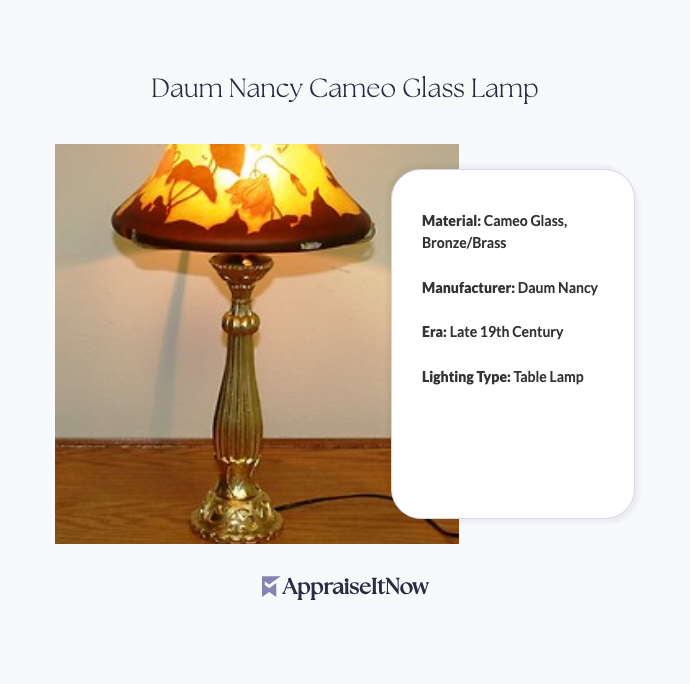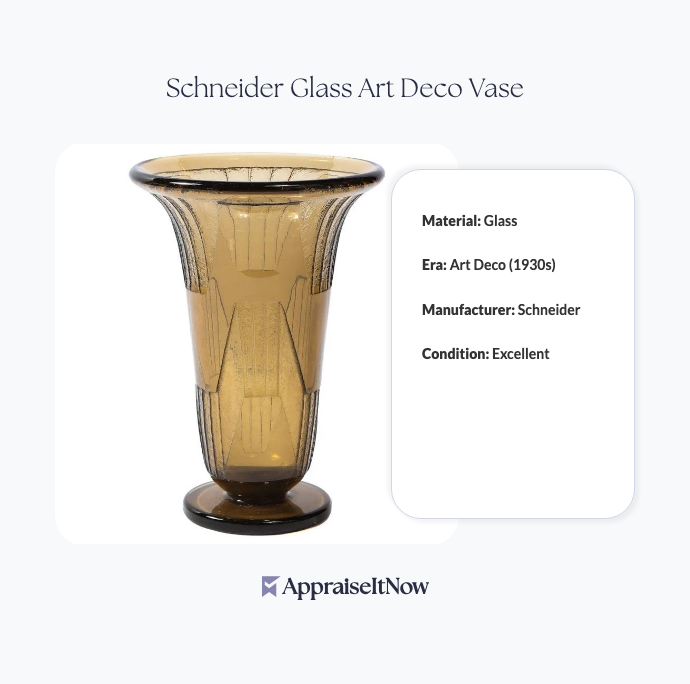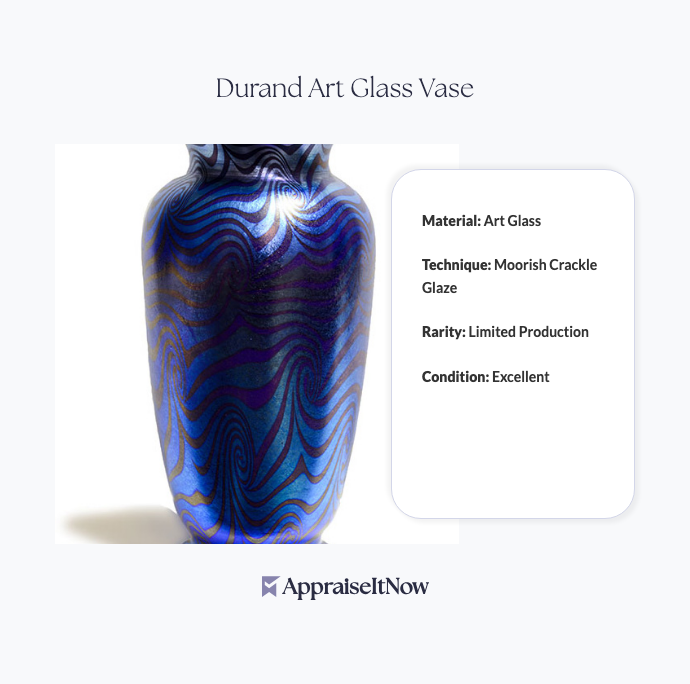<h1>How to Get Your Daum Nancy Cameo Glass Lamp Appraised</h1>
<p>A Daum Nancy cameo glass lamp sits on your shelf—whether inherited, recently acquired, or part of a collection. You might wonder about its value, need documentation for insurance, or plan to sell. Getting it professionally appraised ensures you understand what you actually own and can make confident decisions about this significant piece of French art glass.</p>
<h2>Understanding Your Daum Nancy Cameo Glass Lamp's Value</h2>
<p>Your Daum Nancy cameo glass lamp likely ranges between <strong>$7,000 and $10,000</strong> in today's market, though exceptional examples can command more. This valuation reflects the lamp's rarity, historical significance, and the exceptional craftsmanship embedded in every piece.</p>
<p>Created during the late 19th century in Daum Nancy, France, these lamps represent the pinnacle of art glass innovation. The manufacture process—meticulously carving and layering colored glass to create intricate floral motifs—demanded extraordinary skill. With only approximately <strong>500 pieces produced worldwide</strong>, your lamp represents a genuinely scarce object within the broader landscape of <a href="/types/antique-artwork">antique artwork</a> and decorative arts.</p>
<p><strong>Pro Tip:</strong> Daum Nancy cameo glass lamps first introduced in the 1880s command higher premiums than later reproductions. Authentication becomes your first step in understanding market positioning.</p>
<h2>What Makes Daum Nancy Cameo Glass Lamps Valuable</h2>
<p>Daum Nancy earned its prestigious reputation through revolutionary techniques in glass art. The company combined scientific precision with artistic vision, creating works that transcended functional lighting to become sculptural masterpieces. Each lamp's shade features layers of colored glass—typically amber, green, or blue tones—with deeper shades carved away to reveal the lighter layers beneath, creating dimensional floral or landscape scenes.</p>
<p>The iconic design places the cameo glass shade above a bronze or brass base, melding sculptural beauty with structural elegance. This combination of materials, artistry, and technical mastery directly impacts why Daum crystal commands such premium valuations. When evaluating your piece's worth, professional appraisers examine these fundamental design and construction elements that define the brand's identity.</p>
<p>The question "why is Daum crystal so expensive?" has a straightforward answer: scarcity, technical difficulty, and historical significance converge to create objects of enduring value. Unlike industrial glass production, each Daum Nancy lamp required individual attention, making mass production impossible. This limitation ensures continued collector demand and appreciation potential.</p>
<h2>Authenticating Your Daum Nancy Lamp</h2>
<p>Before pursuing formal appraisal, understand the authentication basics. Original Daum Nancy pieces from the 1880s-1920s typically bear specific markings. The company name appears on the glass itself—either etched, molded, or incised—often accompanied by "Nancy" and sometimes a city mark indicating production location. Quality reproductions exist, and distinguishing originals requires expertise that professional appraisers bring to the table.</p>
<p>Examining the glass quality reveals authentic construction. Real Daum Nancy cameo glass shows variation in coloration, slight imperfections in carving execution, and depth inconsistencies that reflect hand-craftsmanship. Modern reproductions typically display uniform appearance and precise machine-like carving. The base's patina and mounting mechanisms also provide authentication clues—original bronze bases develop characteristic aging patterns impossible to artificially replicate convincingly.</p>
<p>Understanding how to identify Daum crystal involves assessing weight, glass clarity, the precision of the carving, and base construction quality. These factors collectively establish authenticity and significantly affect your lamp's appraised value. When asking "How do I know if my vase is worth money?"—the same principles apply to lamps. Professional appraisers leverage detailed knowledge of production techniques, materials, and maker's marks to confirm authenticity and establish provenance.</p>
<h2>Determining Current Market Conditions</h2>
<p>The <a href="/blog/appraising-fine-glass-and-crystal-valuing-delicate-glassware-and-artistic-creations">fine glass and crystal market</a> has remained relatively stable for Daum Nancy pieces, though values fluctuate based on condition, rarity, and provenance. Your appraisal value reflects what similar examples sold for recently in comparable condition.</p>
<p>Market dynamics affecting Daum Nancy lamps include collector demand concentrated among serious art glass enthusiasts, museum acquisition interest, and the absolute scarcity driving competition among bidders. Unlike mass-produced items subject to supply-and-demand volatility, genuine Daum Nancy cameo glass lamps maintain value stability. The finite worldwide inventory—those 500 pieces—becomes more valuable as time passes and examples disappear into private collections or institutional holdings.</p>
<p>Regional variations exist. European collectors, particularly those in France and Germany, often show different valuation patterns than American buyers. International markets access different examples, sometimes revealing price variations that professional appraisers must account for when establishing fair market value.</p>
<p><strong>Key Market Factor:</strong> Condition significantly impacts value. Even small chips or repairs in the glass reduce appraisal values by 15-30%, making preservation absolutely critical.</p>
<h2>Preparing Your Lamp for Professional Appraisal</h2>
<p>When you're ready to pursue formal valuation, prepare documentation that supports the appraisal process. Gather any available purchase history, family records, or provenance information. Photograph your lamp from multiple angles—including close-ups of maker's marks, the base, and any damage or repairs. Good photography allows appraisers to begin preliminary assessment before conducting in-person evaluation.</p>
<p>Clean your lamp gently before appraisal. Use only soft, dry cloths avoiding any liquid cleaners that might damage original finishes or compromise patina authenticity. How to clean Daum crystal safely? Gentle dusting with microfiber cloth and, if necessary, light surface cleaning with distilled water and soft bristle brushes suffice. Aggressive cleaning or restoration attempts can dramatically reduce value by obscuring original surface characteristics and patina that appraisers use for authentication.</p>
<p>Avoid amateur restoration efforts. Well-intentioned repairs often decrease value more than the original damage. Professional conservators trained in art glass restoration might be necessary if significant damage exists, but this decision should come after professional appraisal establishes baseline condition and value.</p>
<h2>Working with Qualified Appraisers</h2>
<p>Selecting the right appraiser dramatically affects appraisal accuracy and utility. Look for professionals credentialed by recognized organizations—AAA, ISA, ASA, CAGA, or AMEA designations indicate serious expertise and commitment to professional standards. Appraisers specializing in <a href="/blog/the-art-of-appraising-factors-that-determine-the-value-of-fine-art">fine art and decorative objects</a> understand the nuanced factors specific to Daum Nancy valuations.</p>
<p>Ask potential appraisers about their experience with French art glass, familiarity with Daum Nancy specifically, and understanding of current market conditions. They should maintain detailed knowledge of comparable sales—what similar pieces sold for and when. Professional appraisers provide documentation suitable for insurance purposes, estate settlements, or informed sale decisions.</p>
<p><strong>AppraiseItNow</strong> connects you with credentialed appraisers across the U.S. who specialize in <a href="/types/antique-furniture">antique furniture</a> and <a href="/types/household-goods">household goods</a> including decorative lighting. Our platform streamlines the appraisal process by allowing you to submit photographs and descriptions digitally, receiving comprehensive USPAP-compliant valuations without necessarily requiring in-person inspection for initial assessment.</p>
<p>The appraisal report should detail your lamp's condition, authentication findings, comparable market data supporting valuation, and any restoration history. This documentation becomes essential for insurance claims, estate planning, or when you decide to sell.</p>
<h2>Insurance and Protection Strategies</h2>
<p>Once appraised, your Daum Nancy lamp requires appropriate insurance coverage. Standard homeowner's policies typically cover decorative objects only up to limited amounts, leaving valuable art glass lamps significantly underprotected. Specialized fine art or personal property insurance policies provide comprehensive coverage reflective of professional appraisal values.</p>
<p>Update your appraisal every three to five years as market conditions and comparable values shift. How do I know if my lamp is worth money? Beyond the professional appraisal figure, you'll develop understanding through appraiser consultation about what aspects of your specific lamp drive its value and what might threaten that worth through damage or neglect.</p>
<p>Consider climate-controlled storage if you're not actively displaying your lamp. Extreme temperature fluctuations, direct sunlight exposure, and humidity variations can gradually deteriorate glass and damage bronze bases. These preservation measures protect both the object's integrity and its market value. For detailed guidance on protecting your investment, explore our resource on <a href="/blog/what-do-appraisers-look-for-when-appraising-antique-artwork">understanding what appraisers look for in antique artwork</a>.</p>
<p><strong>Insurance Priority:</strong> Attach your professional appraisal to insurance policies specifically documenting Daum Nancy provenance, authentication details, and condition assessment. This documentation streamlines claims processing and protects you if loss occurs.</p>
<h2>When and Why You Need Professional Appraisal</h2>
<p>You should pursue professional appraisal when selling, establishing insurance coverage, planning estates, or settling legal disputes. An appraiser provides objective, market-based valuation grounded in comparable sales data and expert analysis. This contrasts sharply with casual estimates or internet research that rarely account for your specific lamp's unique characteristics.</p>
<p>The question "How can you tell if crystal glass is valuable?" ultimately requires professional expertise. While you can recognize that older pieces, rare examples with exceptional condition, and items from prestigious makers command higher values, precise valuation demands detailed market knowledge and authentication skills. Professional appraisers bring this expertise, providing documentation that stands up to financial institutions, insurance companies, and legal proceedings. Understanding this value extends to broader <a href="/types/artwork">artwork appraisal</a> considerations where rarity, provenance, and condition converge to establish fair market worth.</p>
<hr />
<p><strong>Key Takeaway:</strong> Your Daum Nancy cameo glass lamp—valued between $7,000 and $10,000—deserves professional appraisal that confirms authenticity, documents condition, and establishes current market value. Whether planning to sell, insure, or preserve your piece, a certified appraisal provides the confidence and documentation necessary to make informed decisions about this exceptional example of French art glass craftsmanship.</p>







.avif)







